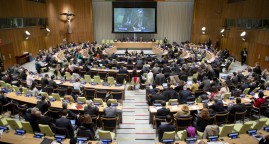Humanitarian action : as local as possible, as international as necessary
Report published on URD website on november 2018
Understanding capacity and complementarity in humanitarian action
The Secretary-General’s call at the World Humanitarian Summit (UN, 2016), that humanitarian action should be ‘as local as possible, as international as necessary’, has triggered a whirlwind of initiatives, processes and debates within the humanitarian community. Whether referred to as ‘localisation’, ‘local humanitarian action’ or ‘locally-led humanitarian action’, the humanitarian sector is grappling with what actions and reforms are needed to allow a more local humanitarian response.
While in principle consensus has been reached in favour of supporting local humanitarian action, the localisation agenda has been interpreted and understood differently by actors at the local level and among ‘traditional’ international humanitarian organisations. As part of the Grand Bargain process, the formal humanitarian sector has committed to more funding going more directly to local organisations as part of a dedicated localisation workstream.
Local, national and international non-governmental organisations have come together under the Charter for Change, committing to principles that support more local humanitarian action. This attention to localisation stems from an awareness – one that in many ways led to the World Humanitarian Summit – that the international humanitarian system is struggling to respond effectively and adequately to humanitarian situations.
There is also a recognition that international actors, donors, international non-governmental organisations (INGOs) and UN agencies have difficulty effectively interacting with local humanitarian actors in ways that depart from the transactional arrangements that have dominated these relationships to date.
Those more sceptical about this this push for a more local humanitarianism argue that a lack of local capacity in most humanitarian crises means that localisation is not a practical proposition. Issues of capacity, capacity strengthening, partnerships, collaboration and complementarity are not new in the humanitarian sector (Smillie, 2001; Telford, 2001; Christoplos, 2005; Harvey, 2009; Pouligny,2009; Eade, 2010; Delaney and Ocharan, 2012; Dichter, 2014). The localisation debate has, however, brought them to the fore. It has also exposed a fundamental lack of clarity around key terms in the debate, not least what actually constitutes ‘local’ and ‘international’, how capacity is assessed, by whom and to what purpose.
Understanding these debates and issues is critical to understanding whether the current diagnosis and proposed solutions to support a more local humanitarian response are the right ones. This Working Paper takes a critical look at this discourse. It argues that defining and assessing capacity is not a technical exercise but a political one; that issues of capacity are not new to the humanitarian sector, but that past efforts at capacity strengthening have not necessarily resulted in more locally-led humanitarian action, in part because they have tended to focus on making local organisations a better fit for partnerships, rather than better or more effective humanitarian actors in their own right; and that, in exploring the interaction between local and international humanitarianism there is a need to identify those factors that support or undermine complementarity between local and international actors.
Related Articles
Migrants significantly contribute to economic growth
09/01/2016. In 2015 alone, migrants sent $432 billion back to developing countries.
Amid record needs, new UN relief chief promises reform
12/05/2017. His predecessors sat in an office of picture windows overlooking the East River fitted with beige furniture on the upper floors of UN headquarters in Manhattan.
A humanitarian’s guide to choosing the next UN chief
04/18/2016. Of the 9 candidates to become the next UN secretary-general, who will bring the most expertise, creativity and focus to the humanitarian agenda?



